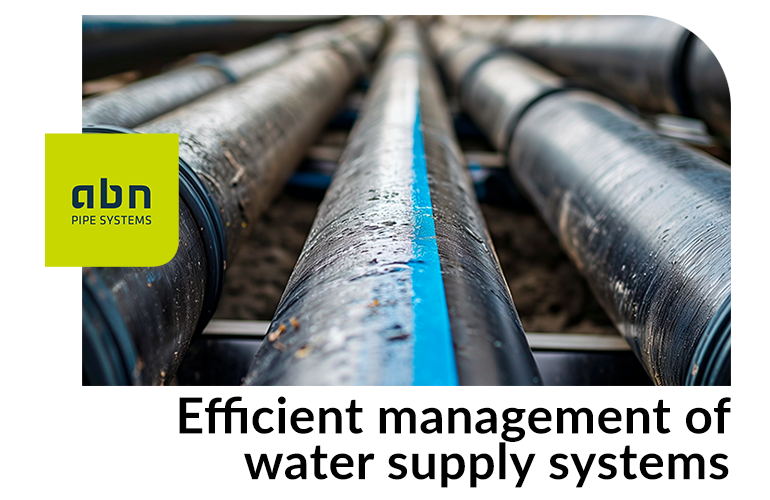In a scenario where access to safe drinking water is increasingly becoming a challenge due to scarcity and more frequent periods of drought, water supply network losses contribute to the problem.
In Spain, the situation is alarming: more than 700 cubic hectometres of water are lost annually due to leaks and breakdowns in the network. These losses are equivalent to the domestic consumption of almost 14 million people, raising alarm bells about the urgency of tackling this problem.
Water loss in the supply network
Water loss in the supply network are defined as the difference between the volume of water supplied to the system and the volume of water registered in the meters of the final consumers. They are divided into real losses, such as leaks and breakages, and apparent losses, which include metering errors and unauthorised consumption.
Since the beginning of the century, these losses represent an alarming 25% of the water supplied, one of the highest rates in Europe. This means that 1 out of every 4 litres of water supplied to the system is lost through leakage or unauthorised consumption each year. Lack of investment and ageing infrastructure exacerbate the situation, highlighting the need for regulatory and investment measures to address this problem in a sustainable manner.
In order to reduce the environmental impact of water losses, the government will oblige municipalities to account for all leaks detected in their supply networks by 2025.
Importance of good water supply network maintenance
Lack of proper maintenance of water networks can have devastating consequences. But this not only compromises the supply of drinking water, it also compromises water conservation and distribution efforts. Pipe bursts are clear indicators of ageing infrastructure, which is essential to maintain the quality of supply and sanitation services.
According to the Spanish Association of Water Supply and Sanitation (AEAS), a large percentage of water supply networks have been in operation for more than 40 years, which exponentially increases the likelihood of water leaks in the pipes.
In the case of the sewerage network, the ageing is even greater, where 44% of the pipes have been in service for more than 40 years. This situation is aggravated by the lack of investment in the renovation of such facilities. The renewal rate stands at 0.6% and 0.38% respectively, well below the target of 2% renewal, which is considered the ideal.
Proper maintenance of water networks is essential to ensure their long-term efficiency and sustainability. Preventive and corrective maintenance plans are required to counteract the progressive deterioration caused by use and time. These plans should include scheduled and regular operations, such as inspections, cleaning and timely repairs of breakdowns. However, in cases where maintenance cannot solve the problems effectively, rehabilitation or even complete renewal of the network may be necessary.
Hazards associated with the lack of maintenance of water supply networks
Lack of maintenance in the supply network leads to significant risks to public health and the environment, some of which may include:
- Leaks in the network can alter the quality of drinking water and lead to health emergencies. The presence of obsolete materials, such as lead, in distribution networks represents an additional hazard. Adequate maintenance measures, including cleaning and disinfection of the network, are essential to ensure a safe and sustainable supply of drinking water.
But there are also dangers caused by lack of maintenance, and some of these can be:
- Possible leaks in the supply network, due to the lack of resistance of old pipes, not only lead to the loss of the resource and material damage, but can also trigger phenomena such as siphoning during periods of depressions, allowing water to enter from outside. These phenomena can alter the characteristics of water before it reaches the consumer, posing a risk to public health.
- Old materials such as lead can lead to water quality problems. It is crucial to detect and remove these materials as far as possible to ensure security of supply.
- Lack of maintenance of valves or lack of knowledge of their exact location can lead to delays in responding to problems, such as the need to isolate an affected area during a health emergency.
- Failure to check hydrants can compromise the service needed in the event of a fire, highlighting the importance of maintaining these devices in optimal condition.
Efficient pipe systems for the renovation of water supply systems
In cases where the network is seriously damaged, it is advisable to replace it in order to avoid failures and breaks, repair costs and inconvenience to neighbours in the affected areas.
Nowadays the best solution when replacing such networks is to use polyethylene pipes for drinking water. These systems are specifically designed for use in water pipelines, both drinking water and fire-fighting networks, guaranteeing their resistance and long life under extreme working conditions.
In addition, their benefits include their long service life – more than 50 years – and the fact that they do not require any type of maintenance. They are also highly resistant to internal pressure, which guarantees the correct functioning of the networks, and to corrosion, a determining factor in the development of legionella.
On the other hand, its great elasticity makes the installation process faster and cheaper, which is very simple, as both the polyethylene pipes and fittings adapt perfectly to winding terrain. In addition, the multiple possibilities of welded joints guarantee 100% watertightness, eliminating future repair costs.
All these advantages make polyethylene pipes an excellent option for carrying out renovation work on drinking water networks, providing durability, efficiency and optimisation in their installation.
